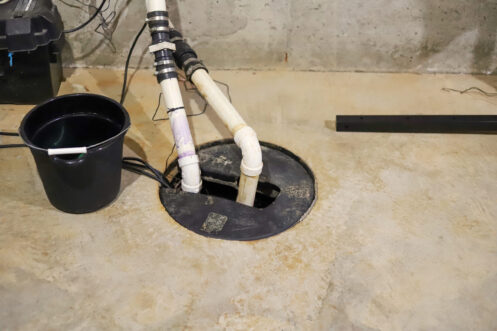
Basement flooding isn’t just a rainy-day problem. It’s a home maintenance issue that sneaks up fast and costs even faster. Whether you’ve dealt with water damage before or just want to avoid it, a sump pump is one of those behind-the-scenes systems that can save you from a lot of hassle. These pumps sit quietly in a low spot in your basement or crawlspace until you need them, and when they fail, you know it. At Fix-A-Leak in Bohemia, NY, we help homeowners determine which type of sump pump would be the best fit for their homes, and we ensure that their sump pumps keep running for the long haul.
How a Sump Pump Works
Your sump pump is typically located in a pit, usually in your basement or crawl space. When water starts building up under your house, maybe from rain, melting snow, or a high water table, it flows into this pit. As the pit fills, a float rises. When the water level rises high enough, the pump turns on and begins pushing water away from your house through a pipe that leads outside. You won’t see it happen, but you’ll notice if it stops working. A working pump keeps your basement dry. A broken one leaves you with puddles, soaked boxes, and ruined carpet.
There are two types: pedestal and submersible. A pedestal sump pump is put above the water, with its motor mounted on a tall stand. It’s easier to reach if something goes wrong. A submersible sump pump goes right down in the water, which makes it quieter and more powerful. Choose the type that best fits the available space.
Pick the Right Pump for Your Home
The most important part of choosing a sump pump is matching the pump to how much water your home usually gets and how deep your sump pit is. Some basements stay dry most of the year, while others take on water every time it rains. If your pump runs often or has to move a lot of water quickly, go for a model with a higher horsepower rating. If your space floods only now and then, a smaller, quieter one will do just fine.
Another thing to think about is the type of switch it uses. Vertical floats are great for small pits, while tethered floats work better in wider pits. Electronic sensors are also an option, but if you’re not into extra tech, a mechanical switch is just fine. You’ll also want to make sure the pump’s discharge pipe runs far enough from your foundation so the water doesn’t just soak back in. A solid ten-foot extension usually does the job.
Installation Tips for a Better Setup
Putting in a sump pump isn’t just dropping it in a hole and plugging it in. You have to dig or use an existing pit that drains well. If you don’t have one yet, you’ll need to break through concrete, dig deep enough to collect water, and make sure there’s gravel around the sides to help water flow in. Once the pit is ready, the pump goes in with the discharge pipe connected and sealed.
You’ll also need a check valve on the pipe to stop water from running backward into the pit. Without one, your pump will have to push the same water out again and again, which wears it out faster. Make sure the power outlet is grounded and not overloaded. If the outlet is too far away, don’t use an extension cord. Get a proper setup installed near the pump to keep it safe. If your basement loses power during storms, it’s smart to have a backup battery or water-powered backup pump ready to take over.
Common Problems
You need to recognize the signs that something is wrong with your sump pump. You might hear them run, but notice water isn’t going anywhere. That could mean the discharge pipe is clogged or frozen. Other times, the pump doesn’t turn on at all, even when the pit is full. That’s usually a stuck float, a power issue, or a motor that’s burned out. If the pump cycles on and off nonstop, the float switch might be stuck in the “on” position, or the pit might be too small for your pump.
You can catch most of these problems early by testing your pump every few months. Just pour a bucket of water into the pit and watch what happens. The float should rise, the pump should kick on, and water should flow out through the discharge line.
Prepare and Fix Your Sump Pump Today
Keeping your basement dry doesn’t have to feel like a guessing game. With the right sump pump and regular maintenance, you can protect your home from moisture-related problems and costly damage. We also offer repiping, leak detection, and water heater replacement services to help protect your home’s plumbing.
If you’re ready to install, replace, or maintain a sump pump, contact the team at Fix-A-Leak, and we’ll help you get it done right.
